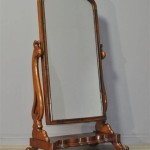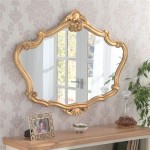Refinish Antique Mirror Frame
Antique mirrors add a touch of elegance and history to any space. However, time and environmental factors can take a toll on the frames, leaving them looking dull, chipped, or damaged. Refinishing an antique mirror frame can restore its beauty and preserve its value for generations to come. This process requires careful consideration of the frame's materials, age, and existing finish to ensure the best possible outcome.
Assessing the Frame
Before beginning any refinishing work, a thorough assessment of the frame is essential. This involves:
- Identifying the frame material (wood, gesso, plaster, etc.).
- Determining the type of existing finish (paint, lacquer, varnish, gilding).
- Evaluating the extent of damage (chips, cracks, water stains, etc.).
- Noting any unique features or decorative elements that need to be preserved.
Cleaning the Frame
Cleaning the frame is a crucial first step in the refinishing process. It removes dirt, grime, and old wax buildup, allowing for a better assessment of the frame’s condition and ensuring proper adhesion of any new finish.
- Use a soft brush or cloth to remove loose dust and debris.
- A mild solution of warm water and a gentle dish soap can be used for cleaning most frames.
- Avoid harsh chemicals or abrasive cleaners, which can damage delicate finishes.
- Test any cleaning solution on an inconspicuous area of the frame first to ensure it doesn’t cause discoloration or damage.
- Dry the frame thoroughly after cleaning.
Repairing Damage
Depending on the extent of the damage, repairs may be necessary before applying a new finish. This could involve:
- Filling small cracks and chips with wood filler or gesso.
- Repairing larger breaks with wood glue and clamps.
- Replacing missing sections of molding or ornamentation if possible.
- Sanding down any rough areas or excess filler.
Stripping the Old Finish (Optional)
In some cases, stripping the old finish may be desirable, especially if it is heavily damaged, flaking, or obscuring the frame's natural beauty. However, stripping should be approached with caution, as it can sometimes damage the underlying material.
- Chemical strippers are available, but they should be used carefully and in a well-ventilated area, following the manufacturer's instructions.
- A gentler approach is to use fine-grit sandpaper to carefully remove the old finish.
- Test the stripping method on a small, inconspicuous area first to ensure it doesn’t harm the frame.
Choosing a New Finish
Selecting the appropriate finish is crucial to achieving the desired aesthetic and protecting the frame. Consider the following factors:
- The original finish of the frame (if known).
- The style and age of the mirror.
- The desired level of sheen (matte, satin, gloss).
- The type of protection needed (water resistance, UV protection).
Common finishes for antique mirror frames include paint, lacquer, varnish, and gilding.
Applying the New Finish
The application process varies depending on the chosen finish, but some general guidelines apply:
- Work in a well-ventilated area.
- Apply thin, even coats to avoid drips and runs.
- Allow each coat to dry completely before applying the next.
- Use high-quality brushes or spray equipment for a smooth, professional finish.
- Lightly sand between coats (if necessary) to achieve a smooth surface.
Protecting the Finish
Once the new finish has cured completely, consider applying a protective layer to prevent future damage. This could include:
- A clear coat of varnish or lacquer.
- Wax for added sheen and protection.
Regular dusting and gentle cleaning will also help preserve the finish and extend the life of the restored antique mirror frame.
Gilding (Optional)
Gilding is a specialized technique for applying thin sheets of gold leaf or other metallic materials to a frame. This process adds a luxurious touch and can be used to restore antique frames that were originally gilded.
- Gilding requires specialized tools and materials and is best left to experienced professionals.
- Various gilding techniques exist, including water gilding, oil gilding, and composite gilding.

12 Techniques To Painting Antique Mirrors Hallstrom Home

12 Techniques To Painting Antique Mirrors Hallstrom Home

Chalk Painting An Antique Mirror Frame Tutorial Rise And Renovate

12 Techniques To Painting Antique Mirrors Hallstrom Home

12 Techniques To Painting Antique Mirrors Hallstrom Home

How To Paint A Mirror Frame Antique White Well Purposed Woman

From Drab To Fab In 10 Minutes Vintage Mirror Frame Makeover Zle Design

How To Refinish An Antique Mirror With A Dark Stained Frame Celebrated Nest

How To Paint A Mirror Frame Gold Remodelando La Casa

12 Techniques To Painting Antique Mirrors Mirror Diy








